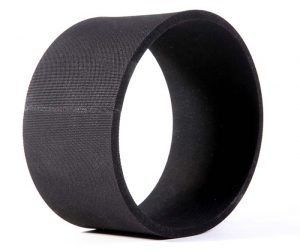Sponge rubber seals
Unlike cellular rubber, sponge rubber is a mixed-cell, elastic foam based on various rubbers such as CR (chloroprene rubber), NR (natural rubber), NBR (nitrile rubber), EPDM (ethylene-propylene-diene rubber) and other synthetic variants. At Rehm Dichtungen Ehlers GmbH, sponge rubber based on EPDM is available in rolls and sheets.
Sponge rubber materials available from Rehm Dichtungen Ehlers GmbH
If you need highly elastic material with high restoring forces and good resistance to weathering and ozone as a sealing material or insulation material, you can fall back on sponge rubber based on EPDM. The material is available in sheet and roll form. Due to our different manufacturing processes, you can not only purchase yard goods from us, but also individual products, such as cut-to-size, seals or flat seals or strips.
Sponge rubber EPDM
Import quality, open-pored
Technical data sheet:
Properties:
| Hardness [Shore A] | ISO 7619-1 | 50 35° |
| Density [g/cm³] | ISO 1183 | Approx. 0.8 |
| Elongation at break [%] | ISO 37-S2 | 150 |
| Operating temp. range [%] | -20° to +70° C |
The properties of sponge rubber as a sealing material
When propellant gases are added, the base material rubber is turned into sponge rubber. The surface is smooth, the cells are open on the inside. As a result, the surface is protected against foreign influences and has good sealing properties.
The material is particularly suitable for outdoor use.
The advantages and material properties of sponge rubber at a glance
Depending on the choice of base, sponge rubber made of EPDM has a number of good material properties. In general, the foamed material is excellently suited as a seal, as it adapts to the respective surface conditions and thus seals well. Thanks to its closed, smooth surface, sponge rubber is resistant to moisture. The closed outer skin of the material also results in a very high abrasion resistance. However, if the structure of the outer skin is damaged, the material loses this ability due to the open pores inside. Seals and gaskets made of sponge rubber also have good damping properties and high compressibility.
Other good material properties include:
- High pressure elasticity
- good resilience
- positive cold behaviour
- Air permeability
- Ageing resistance
- High formability
- Temperature resistance between -40° C and +90° C
- Weather resistance
EPDM foam rubber is also highly resistant to ageing, ozone, weathering and light, which is mainly due to the EPDM content. A disadvantage is the very poor bondability of the material. Depending on the chosen base material, there are individual, special adhesives that are particularly suitable where no high mechanical or thermal forces act.
Differentiation of sponge rubber seals from cellular rubber
Both sponge rubber and cellular rubber belong to the group of foamed materials. However, both sealing materials differ with regard to some properties and characteristics. While sponge rubber is a mixed-cell material characterised by high pressure elasticity and good resilience, cellular rubber is a closed-cell sealing material. The mixed-cell material requires a closed outer skin in order to function as a sealing material. This is not the case with cellular rubber, as the material is airtight and watertight.
Areas of application for sponge rubber seals
Foam rubber can be used in a variety of ways as a sealing and insulating material and is processed by us, with the help of our various manufacturing processes, in the form of cut-to-size parts, stamped parts or water-jet cut seals. For example, the sealing material is used as a door seal, protective mat, anti-slip mat or insulating underlay. The material also offers a cost-effective solution for sealing large openings in containers, tanks and housings.
We will be happy to answer whether the material is also suitable for your application purposes. Please contact our customer service for comprehensive advice.


